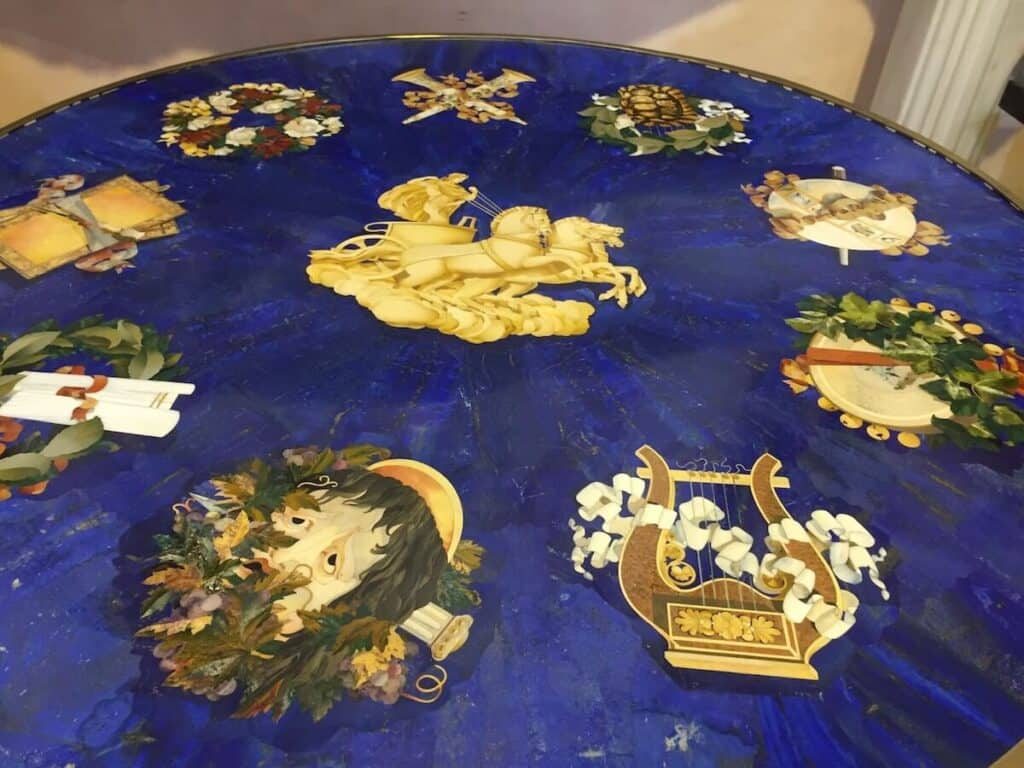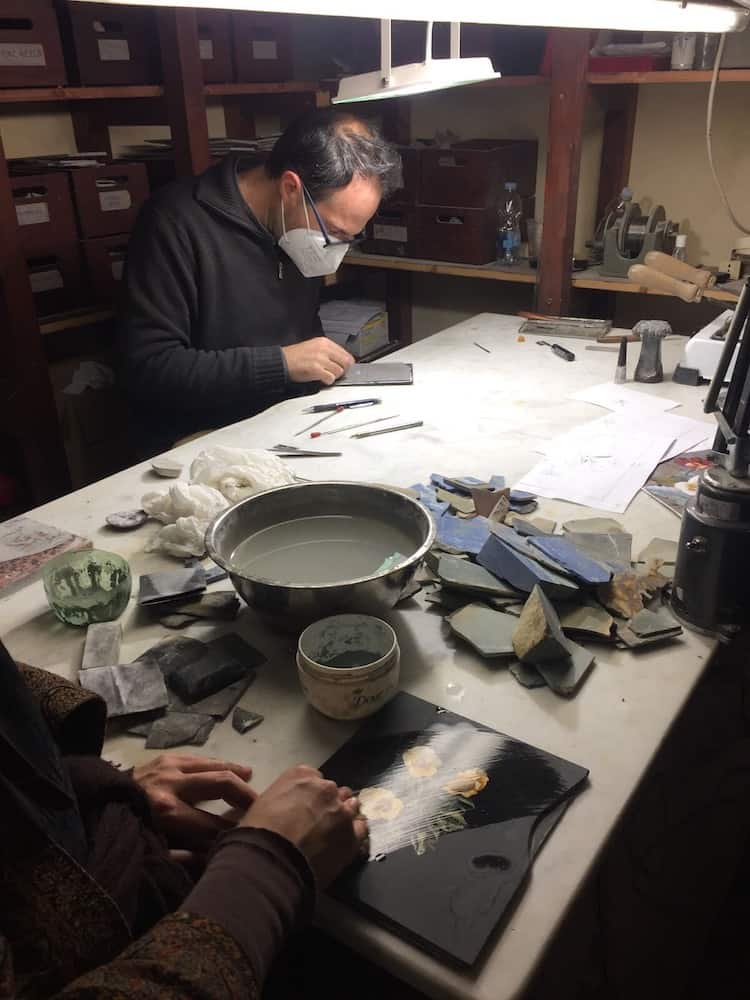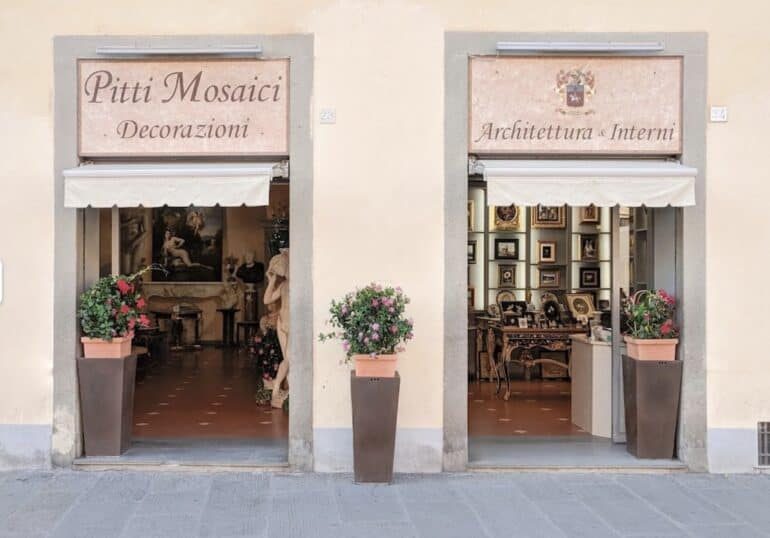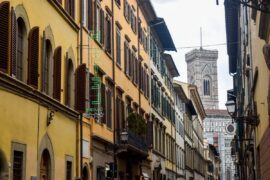A hands-on experience of the traditional Florentine mosaic, the Pietra Dura
Directly outside the Palazzo Pitti, in the spot where the old palace stables used to be, stands the sort of picturesque shop you could walk past on your way to aperitivo, without realising what is inside. I urge anyone who is in Florence to stop by this shop and find out more about one of the city’s last artisan mosaic businesses. Upon first entering, knowing nothing about Pietra Dura mosaics, I met a retired English couple who were looking to decorate their new villa with some local artwork. As they talked prices I found out the answer to the age old question, ‘can you put a price on art?’ Yes, as it turns out you can. And it can be expensive. I was soon given a tour of the workshop and an outline of its history.
The craft of Pietra Dura is a Florentine style of mosaics, creating artwork through the use of hard and semi-precious stones, utilising the natural colour of the stones. Although around since the Roman period, the history of modern Pietra Dura work originated in Florence. Since the days of the Medici, Pietra Dura has spread throughout the world, stretching as far as the Taj Mahal.

How Is It Made?
This unique piece, found in the Pitti Mosaici showroom, is an example of a Pietra Dura mosaic. It depicts Apollo, the protector of art and culture. The table is a reproduction from 1837. The more detailed original was worked on for 13 years, and is on exhibition in Palazzo Pitti, just across the road. The reproduction piece took the artisans three years of dedication to complete. The amount of time and money invested in the modern table, although less than the original, is still extraordinary. It is an example of the modern craft at its best.
Unlike other mosaics, Pietra Dura often is so delicate it can be mistaken for a painting, rather than artwork made from stone. The zero gap is an important aspect of the craft. It refers to the absence of space between each stone piece. The meticulousness of the work and how well this is done will affect its value. To create a piece one must make a drawing, trace it, divide it into the colours needed, and then find the perfect stone to match the colour. The stone is cut with a bow-like tool made from chestnut and iron (the same tool used in the Renaissance), and then polished with water and a smeriglio (similar to iron shavings), which prevents the artwork from being affected by the elements and its surroundings. Final polishing is made with wax, which protects the surface from minor scratches and weather conditions, and helps to keep the art shiny.
There are two main ways to create Pietra Dura. The first is by joining many little pieces of stone together, and the second, more used way involves searching for larger, unbroken pieces of stone to create the desired image. The idea of not breaking up the stones is to keep the work closer to nature. Stones are gathered from all over the world so the artisans can find the most specific colours for their work, as I found out inside the Pitti Mosaici workshop.
The collection of hard and semi-precious stones line the entrance to the workshop. The stone changes and reveals its true colour when wet, as demonstrated by our excellent guide.
Inside The Workshop
As indicated by its definition, pictorial mosaic work using hard and semi-precious stone (it sounds better in Italian, pietre dure e semi-preziose), the artisans are more interested in the colour of the stone, than its type or value. Stones come from all over the world, as I was shown as we walked through the workshop; stones such as lapis lazuli from Afghanistan, malachite from the Congo, amethyst from Brazil, and rhodonite from the States. As well as these many are sampled closer to home – Paesina is a Tuscan stone, used to depict landscapes, which is one of many Italian stones used.
Past the stones we come to the workbenches, where the three artisans are busy at their craft, ignoring the journalist taking pictures of them. Gabriele, the longest serving artisan in Pitti Mosaici, joined when he was 15. He was taught the art from Ilio de Philippis, the owner. Luca, similarly learned his trade here and has been working for over 20 years. Mauro was the third and final artisan from outside the family, and the only one to learn his trade elsewhere. The three men have dedicated their life to this craft in a way that seems very out of date in today’s world of Tiktok and Depop. I felt they would be more suited under the watchful gaze of Lorenzo de Medici.

Besides the three artisans, the two sons, Iory and Isse, also work in Pitti Mosaici. Both sons were taught the craft from a young age, but Iory, the younger of the two, specialises in restoration, an important aspect of the craft, as giving older pieces a new light is a key aspect of the business. Pitti Mosaici is a family run business that has seen four generations of Pietra Dura craftsmen.
One of the main pieces being worked on was a reproduction of a great artwork by Mario Montelatici (I had not heard of him, but I was assured he is a big name in the Pietra Dura world). Mario Montelatici (1894 – 1974), was a great Florentine artist. The artisans at Pitti Mosaici look to reproduce one of his pieces, ‘Street Urchin With Dog’.

Mario Montelatici’ “Street Urchin With Dog” in reproduction. 
The view from the workbenches of the artisans of Pitti Mosaici.
The trip to the workshop made me hungry for more knowledge of the craft. The Pitti Mosaici website is a good place to start. Or, if you can squeeze past the – frankly quite rude – staff, maybe check out the Opificio Delle Pietra Dura for a better understanding of the craft, as although they have many different types of artwork there, they include many famous and impressive pieces of Pietra Dura. As impressive as it is, Pietra Dura is a dying art in Florence. When Pitti Mosaici was founded in 1982, there were another thirty shops like it in the city. Now there are only three, with around ten artisans still working.
Looking at the Pietra Dura mosaics you may find, as I did, an eclectic mix of products. Some are incredible works of art, others resemble something your tasteless auntie might have in her living room. Whatever your thoughts on the aesthetic, this dying Florentine tradition may not be around forever. While still here, a piece of Renaissance Florence lives on; it should be championed as the great historic art form that it is.
Address
Pitti Square 23 red











